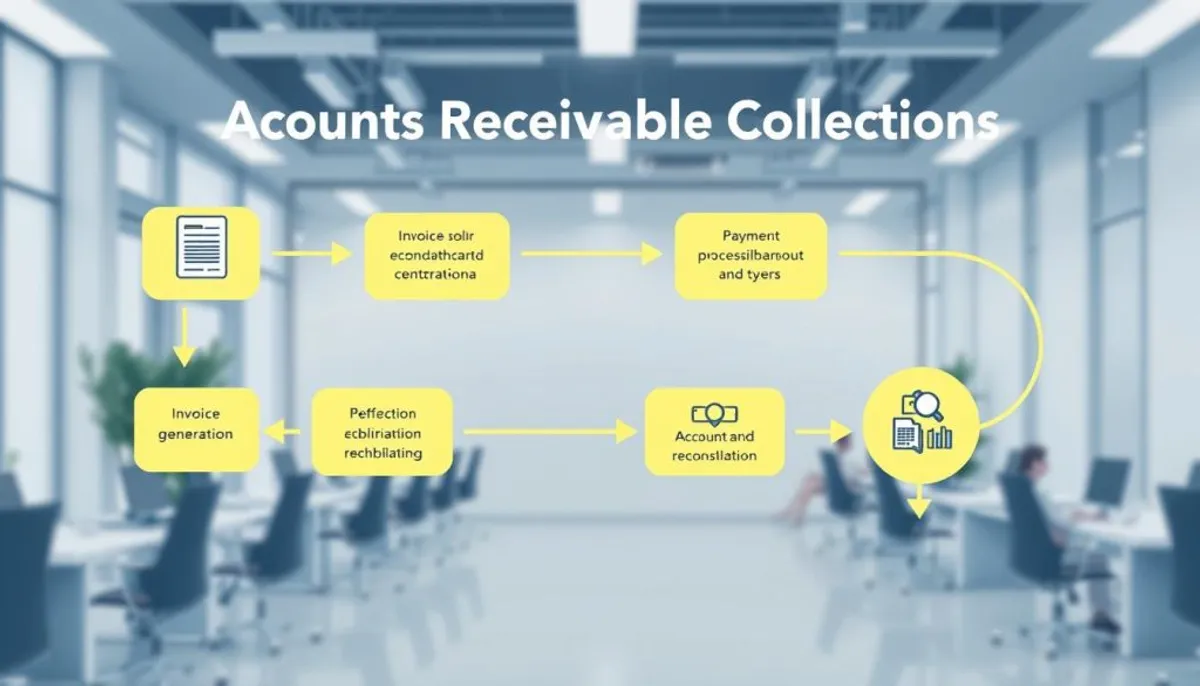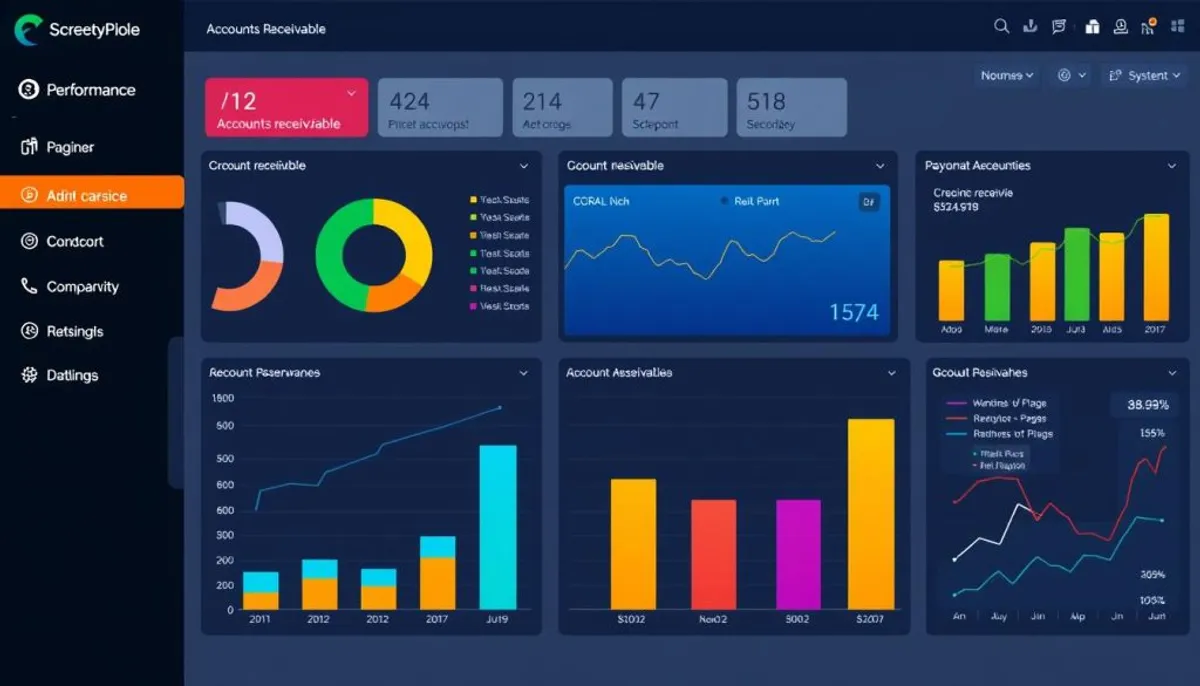Welcome to your definitive guide for excelling in accounts receivable collections. In today’s dynamic business landscape, effective cash flow management is paramount. This comprehensive guide will introduce you to cutting-edge debt collection strategies. These methods will revolutionize your AR process, enhance your financial performance, and ensure customer satisfaction.
Did you know that proficient AR management can significantly reduce your Days Sales Outstanding to under 30 days? Or that AR automation can dramatically increase your collection rate to 99%? We will dissect these transformative techniques and more. You will learn how to transform your AR department into a highly efficient, cash-generating entity.

We will cover everything from establishing clear payment terms to leveraging advanced technology. You will discover how to develop effective credit policies, streamline collection processes, and harness digital tools. We will also provide insights on fostering robust customer relationships during the collection phase. Remember, content clients are more likely to pay on time!
Are you prepared to transform your accounts receivable collections? Let’s embark on this journey together. We will unlock the secrets to a healthier cash flow and a more resilient business!
Accounts receivable management is pivotal for maintaining financial health in businesses. We will explore the essential components of this process and its role in optimizing cash flow.
Accounts receivable are funds owed to a business for goods or services provided on credit. This financial asset is crucial for companies that extend payment terms to customers. Effective management involves tracking owed money, creating invoices, and processing payments.
AR significantly influences a company’s cash flow. Timely collection of owed funds ensures a steady cash flow, supporting daily operations and growth initiatives. Most businesses aim to complete accounts receivable collections within 30 to 90 days to maintain optimal cash flow.
The collection process is vital for timely fund recovery. It encompasses several critical steps:
Efficient accounts receivable management and a structured collection process are essential for cash flow optimization. By implementing these strategies, businesses can reduce uncollected payments and enhance their financial health.
Effective accounts receivable (AR) management is critical for maintaining a healthy cash flow. With 82% of small businesses failing due to poor cash flow management, implementing robust strategies is vital. Let’s explore key approaches to optimize your AR processes.
Clear payment terms are the cornerstone of successful collections. Offering a 2% discount for early payment within 10 days can encourage prompt settlements. This approach not only enhances cash flow but also fosters positive client relationships.
Solid credit policies are essential for minimizing risk and ensuring timely payments. Consider these strategies:
Efficient collection procedures are crucial for reducing Days Sales Outstanding (DSO). Implement these tactics:
By focusing on these strategies, businesses can significantly improve their AR management. Efficient AR processes allow companies to access more of their revenue, reducing the nearly 25% of monthly income typically tied up in unpaid invoices.
Modern collection techniques have revolutionized the field of accounts receivable management. Digital AR management systems are now essential for streamlining processes and enhancing efficiency. These advanced tools tackle common issues like invoice disputes and delayed payments.
A recent survey of C-level executives uncovered interesting facts about invoice disputes:
To address these challenges, companies are turning to digital AR management solutions. These systems automate reminders, decrease errors, and ensure clear communication. For instance, automated reminders sent three days before due dates have shown to enhance payment timeliness.

The move towards electronic payments is another critical aspect of modern collection techniques. While many B2B businesses still accept paper checks, switching to digital payments can greatly reduce days sales outstanding (DSO). This shift is vital, given the rise of remote work and the need for digitalization in accounts receivable processes.
By adopting these modern collection techniques and embracing digital AR management, businesses can optimize their accounts receivable processes. This leads to improved cash flow and stronger customer relationships.
Technology has transformed the realm of accounts receivable collections. Businesses now employ digital tools to enhance efficiency and cash flow. Let’s examine how contemporary solutions are reshaping the collections landscape.
Digital payment solutions streamline transactions for customers. These platforms offer a variety of payment methods, from credit cards to digital wallets. By providing such options, businesses can expedite payments and diminish delays.
AR automation software simplifies collection processes. It manages tasks like invoice generation, payment reminders, and report creation. This technology can reduce cash collection time by up to 80%, allowing staff to focus on more strategic endeavors.
Customer communication tools enhance the collection process. They facilitate timely reminders and personalized follow-ups. These platforms aid in maintaining positive relationships while ensuring prompt payments.
The impact of technology on collections is profound:
By embracing these technological advancements, businesses can revolutionize their AR collections. They will witness improved efficiency, reduced costs, and stronger customer relationships. The future of collections is digital, and it’s here to stay.
In the realm of accounts receivable, fostering robust customer relationships is paramount. With 8 out of 10 Americans burdened by debt, businesses encounter hurdles when clients fail to meet payment obligations. The paradigm has evolved, emphasizing the importance of nurturing positive connections throughout the collection process.
Customer relationship management in collections necessitates a nuanced approach. It entails grasping customer hurdles while adhering to business objectives. This strategy involves transparent communication, empathy, and adherence to ethical standards. By eschewing aggressive tactics and concentrating on finding solutions, enterprises can transform collections into a service-oriented endeavor.
Adherence to collection ethics is vital for establishing trust. Managing sensitive financial data demands meticulous care and professionalism. When executed correctly, it cultivates loyalty and confidence among clients. This trust-building transcends mere debt recovery, becoming a continuous priority from initial contact to post-payment interactions.
Effective strategies for cultivating strong relationships include:
By prioritizing customer relationships alongside revenue objectives, businesses can diminish overdue accounts, enhance cash flow, and acquire valuable insights for data-driven decision-making. In today’s interconnected world, every interaction significantly influences your brand’s reputation and long-term prosperity.
Effective accounts receivable management hinges on tracking key AR performance metrics. These metrics are crucial for assessing collection effectiveness and pinpointing areas for enhancement. Let’s examine essential indicators that facilitate the optimization of AR processes.
AR KPIs offer invaluable insights into collection performance. The Accounts Receivable Turnover Ratio, derived from Net Credit Sales divided by Average Accounts Receivable, reflects collection efficiency. A higher ratio signifies superior collection practices.
The CEI gauges the capability to collect funds within a stipulated timeframe. It’s computed by dividing actual collections by the target amount. A CEI nearing 100% underscores robust collection strategies.
DSO is a pivotal metric, illustrating the average time to collect payment post-sale. It’s calculated as (Accounts Receivable / Gross Revenue) * Number of Days in Period. A lower DSO signifies expedited collections and enhanced cash flow.

By consistently monitoring these AR performance metrics, you can discern trends, establish benchmarks, and make informed decisions to boost collection effectiveness. The ultimate aim is to sustain a healthy cash flow while fostering positive customer relationships.
The ti3 platform is revolutionizing accounts receivable management with its innovative approach. It offers businesses a powerful tool to streamline AR processes and enhance collection efficiency.
The ti3 platform features an advanced automated AR management system. It sends timely payment reminders to customers, reducing the need for manual follow-ups. This automation ensures consistent communication with clients, increasing the likelihood of prompt payments.
Ti3’s streamlined collection process simplifies AR management. The platform automates issue escalation and payment collection, allowing businesses to focus on core operations. This efficiency boost can significantly improve cash flow and reduce the time spent on collections.
Traditional collection agencies can be expensive and may damage customer relationships. The ti3 platform offers a cost-effective alternative, maintaining positive client interactions while achieving collection goals. By leveraging automated AR management, businesses can reduce costs and improve collection efficiency without sacrificing customer goodwill.
By adopting the ti3 platform, businesses can revolutionize their AR collections, improve efficiency, and maintain strong customer relationships.
AR challenges affect businesses of all sizes. Payment delays are a major issue, disrupting cash flow. Many companies still use manual processes, leading to slow collections and errors in invoices and customer records.
To tackle these problems, several strategies can be employed:
Automation is key in overcoming AR challenges. It streamlines processes, cuts down on errors, and simplifies data management. By consolidating data into a single platform, businesses can create real-time dashboards with critical KPIs. This enables them to make proactive decisions.
Timely AR collection is essential for meeting financial obligations. By tackling collection obstacles directly, businesses can enhance their cash flow and maintain strong customer relationships. Technology and data analysis help identify patterns and address potential issues before they arise. This approach reduces payment delays and boosts overall collection performance.
Mastering AR best practices is essential for business survival. With 25% of companies facing bankruptcy due to late payments, optimizing your collection strategy is more important than ever. Efficient AR processes can significantly improve cash flow and reduce bad debt levels.
Leveraging technology is key to optimizing your collection strategy. Automated tools like Upflow’s A/R software offer customized payment reminders, streamlining the collection process. This automation not only reduces manual errors but also speeds up payment processing, directly impacting your bottom line.
Building strong customer relationships is equally vital. Personalized communications and clear credit policies can drastically improve payment timeliness. Collaboration among client-facing teams is essential for successful accounts receivable collections. By prioritizing accounts based on client balances and offering incentives like early payment discounts, you can encourage faster payments and maintain healthy cash flow.
In today’s fast-paced business world, staying on top of your AR through aging reports and embracing automation is no longer optional—it’s a necessity. With these AR best practices in place, you’ll be well-equipped to navigate the challenges of modern business finance and ensure long-term success.